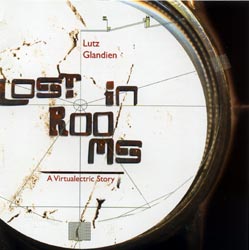
Glandien's third Recommended Records release finds him again in the electroacoustic realm, similar to his album The 5th Elephant, but with even richer sonorities and a more impressive dynamic. This work, described as a "Virtualectric Story," is carefully constructed from electronic sources, vocal narrative, acoustic and vocal samples, and rhythmic loops. Glandien has worked in a variety of compositional and orchestration styles but seems most comfortable in the electroacoustic realm.
What distinguishes and defines Lost in Rooms is the narrative from Canadian dancer Daelik. The story commences at the opening of the CD, describing Daelik's recollections of the house he grew up, and the various rooms within. The tone of the tale is optimistic: Daelik clearly valued his upbringing in the house he describes, and found it and the surrounding area a source of imagination and exploration. He relates his upbringing in a familiar way that makes the story comfortable and interesting - no small feat for a series of simple recollections. He carries the narration through to the modern day, where he returns to see the house which his sister now occupies changed and foreign to him.
Glandien guides the stories with rich tones that breathe life into the various vignettes, making unusual but embraceable audio environments. In addition to the narration there are several sampled voices throughout that help accentuate the story, and become vehicles for the rhythmic sections of the work. His pieces build slowly, using samples to segway major sections, such as the train samples that foreshadow Daelik's description of "tight-rope walking" the train rails nearby. Other pieces work as aural descriptions, as in "Huge Kitchen," which imparts the sense of a vast room through spacious sound. "Four Bedrooms" intercuts samples of Daelik's interphrase breathing and the fragments of his words to great affect.
Glandien generally yields to and complements the tale, focusing on intentions and generating a sense of awe and mystery. His tonal pallette is wide, and his use of samples sophisticated and subtle. The sound weakens in the more overt percussive sections, where the quality of sound is thinner and the rhythms more static than in the more freeform pieces. That is the minority of the work, and in the larger perspective this is a well organized and mature electroacoustic piece.
Comments and Feedback:



More Recent Reviews, Articles, and Interviews @ The Squid's Ear...


|

